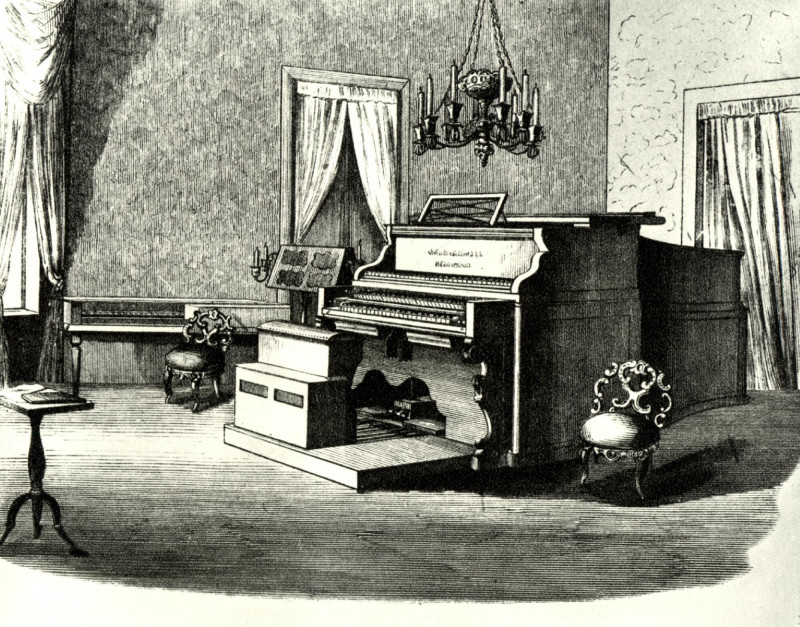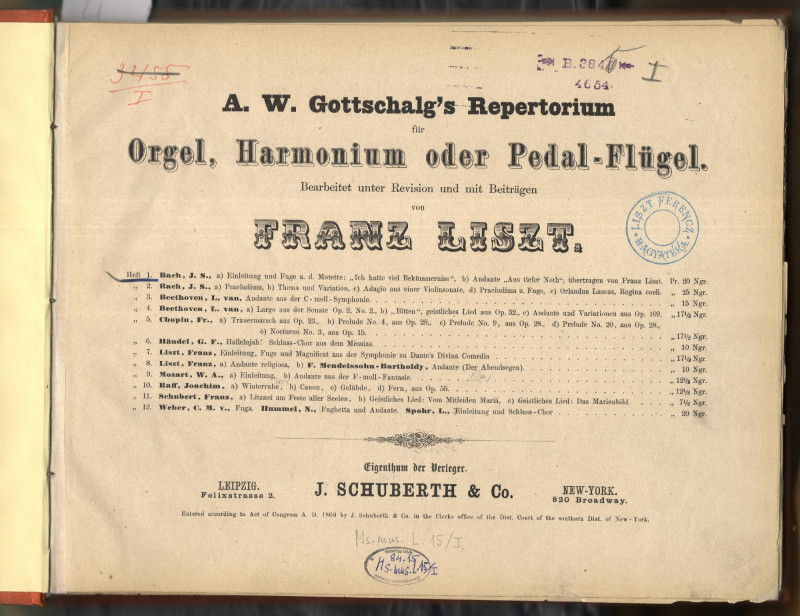The queen of instruments in Liszt’s oeuvre
Article written by Zsuzsanna Domokos in the 12th Concert Magazine of the Liszt Academy
The first written accounts of Liszt as an organist date back to his heyday as a virtuoso. Both the writer Georges Sand and the linguist Adolphe Pictet wrote of Liszt’s improvisation on the church organ in the Cathedral of St. Nicholas in Fribourg during a tour of towns in Switzerland in December 1836. The French poet Joseph Autran (1813–1877) also shared his experience of a lifetime in 1845 after Liszt played on the organ of the Cathedral of La Major in Marseille for him alone, probably anticipating the thematic material for his well-known piano piece, the Dante Sonata: “He played, he improvised, a passionate and magnificent symphony based on Dante’s Divina Commedia, of which we had been talking just previously. In succession he led me through the Inferno, Purgatory and Paradise, with a range of expression and emotion, the recollection of which will never fade from my memory. The sea, in the intervals, roared on the shore in a confused din of applause. Such a chef d’oeuvre for a single listener, this really was more than munificence. This music, which ought to have demanded an admiring crowd, spread through the empty church with an overflow of sonority that at times became terrifying.”

The first pipe organ associated with Liszt was an instrument with one manual and no pedals in the church of his native village of Doborján (Raiding) in the Burgenland region of Austria that borders Hungary. It was built with a donation of 100 ducats the composer had made during a visit home in 1840. Previously exhibited at Liszt’s birthplace, which has been re-opened as a museum, the instrument is currently being restored and is scheduled to be displayed in working condition in Raiding next autumn.
It was presumably Mendelssohn’s prompting that led Liszt to take a profound interest in Bach’s organ music. In 1840 Mendelssohn, who himself composed pieces for the organ, gave a performance of Bach’s organ works in St. Thomas Church in Leipzig. Schumann was keen to write about this concert. Not much later, in 1841 Liszt wrote literal piano transcriptions of Bach’s Prelude and Fugue in A minor and of that in E minor, and the very same year he included these pieces in his piano performances in Berlin. From 1845 onwards, Schumann composed a few works for the pedal piano, an instrument used by organists for practice at home. This may have prompted Liszt to install such a “piano-organ” in his home in Villa Altenburg in Weimar. This complex instrument was made in 1854 under the supervision of Berlioz by the Paris-based firm of Alexandre Pére et Fils, using an 1853 Érard concert piano. It was a huge combination of piano and harmonium with three manuals and a pedal board. It was named the “Piano-Liszt” by the firm. Today the instrument, which is still in working condition, is exhibited in the Gesellschaft der Musikfreunde collection in Vienna.
This musical instrument was used by Liszt in 1850 in composing his great four-part fantasia on themes from Giacomo Meyerbeer’s opera The Prophet. Originally, he had envisaged the fourth part, the fantasia and fugue based on the chorale melody “Ad nos, ad salutarem undam”, for four hands, with the second player also working the pedals. A minor change was called for such that the piece would be performed by one player on the organ. This monumental work, one of the most renowned organ pieces by the composer, is only known today in this version as Liszt’s first and lengthiest original organ composition. His second major organ composition was the Prelude and Fugue on the B-A-C-H Theme, of which a transcription was also written later for piano. During his Weimar years, the organ also played an important role in works he composed in different genres, e. g. in the Gran Festival Mass, the Faust Symphony, the symphonic poem Hunnenschlacht (The Battle of the Huns) and the last section of the Dante Symphony, known as The Magnificat. However, in his oratorios the choral parts are definitely supported by the harmonium as is the case in the movement “O filii et filiae” in the Christus oratorio, and in the chorus of angels in The Legend of St. Elizabeth. Invented in the early 19th century, the harmonium was originally intended to resemble the organ, yet be suitable for flexible dynamic transitions. In Liszt’s oeuvre, the harmonium was used to play liturgical music or pieces with a religious character, partly to provide accompaniment to choral works and partly as an alternative instrument for certain organ works without any pedal parts and even for pieces intended for the piano. The stylized simplicity of Liszt’s late organ works, e. g. Rosario or the Missa pro Organo (Organ Mass), both composed in 1879, is closely linked to the church music reform ideas of the Cecilian movement. The piece Via Crucis was also composed in this style. Completed by Liszt in his Budapest apartment in 1879, the organ setting of the latter is one of the most precious autographs of the Liszt Ferenc Memorial Museum of Budapest.

The library in Liszt’s apartment in Budapest included the volumes for Repertorium für Orgel, Harmonium oder Pedalflügel, a series of organ compositions brought out by Wilhelm Gottschalg (1827–1908). Gottschalg, who maintained close ties with Liszt’s Weimar circle, was a teacher and organist in Tiefurt, near Weimar, and then, from 1870 became the court organist to the Weimar Grand Duke. One of Gottschalg’s goals was to provide his fellow organists with conceptually valuable yet technically not too demanding organ music. He had this goal in mind when he launched his organ series, which had been revised by Liszt, who from that time on had most of his organ works published in them. These works included the organ transcription of the “Offertorium” movement from the Hungarian Coronation Mass, which had originally been composed for orchestra. During his Weimar years, it might have been his relationship with Gottschalg that led Liszt to enrich organists’ repertoire with transcriptions of both his own works and works by other composers (Bach, Chopin, Lassus, Otto Nicolai, Wagner and Verdi) intended for other instruments.
both of which are still in working condition and held in the Liszt Ferenc Memorial Museum. The first one is a so-called “piano-orgue” or “pianoharmonium”, a smaller version of the complex instrument used in Weimar. It was commissioned by Liszt himself when he was in Rome. The instrument has two independent manuals: the upper one belongs to the piano, and the lower one is part of the harmonium. According to Berlioz, the effects of this hybrid instrument resemble an orchestral sound. The piano part of the “piano-orgue” was constructed by Sébastien Érard in the autumn of 1864, and the combined instrument was made by Alexandre Pére et Fils in 1865. At first, Liszt used this “piano-orgue” when he was in Rome, and then he had it sent to the city of Pest (in present-day Budapest) in 1871, when he rented his first permanent residence in Nádor Street in the city centre. Later it was used in his various service apartments in Budapest. The second important musical instrument is a large American concert harmonium, a so-called “Cabinet Organ”, which was given to Liszt in 1877 by the Boston-based company Mason & Hamlin.

It is less known that the first pipe organ set up in the grand building of the Academy of Music on Sugár (now Andrássy) Avenue was chosen by the founder–president of the institution, Ferenc Liszt, and its first director, Ferenc Erkel. At Liszt’s request, Erkel sought to establish the Departments of Organ Music and of Choir Singing (which essentially covered church music) in 1876, but these subjects were only included as late as in the curriculum of 1882–83. The conditions in the new building made it possible for the institution to build a new organ and to establish new departments. The new organ in the concert hall had two manuals, 54 keys and 22 registers, and it was made in the workshop of Antal Dangl and Son in the city of Arad (in present-day Romania). Liszt was pleased with both the beauty and sound of the organ. So he wrote about the performance of the instrument to the builder itself: “With the perfectly built organ in the Royal National Hungarian Academy of Music, you have provided beautifully sounding proof of your skill.”
The first pipe organ at the Academy of Music was inaugurated on 16 February 1883 by the then 30-year-old Hans Koessler, the first professor of the organ and later professor of composition at the conservatoire. Koessler, who later taught Bartók, Dohnányi and Kodály, had the opportunity to play on both of the pipe organs at the Academy of Music: as a young professor, he played on the institution’s first instrument in the grand old building on Sugár (now Andrássy) Avenue, and later he also played on the Voit organ in the Grand Hall of the new building erected in 1907.
Nevertheless, it is no coincidence that at the inauguration ceremony for the Academy’s first pipe organ, the organ transcription for the orchestral introduction to the oratorio The Legend of St. Elizabeth was also played by Koessler, among other compositions, in the presence of the composer: the president of the Academy.
Zsuzsanna Domokos


